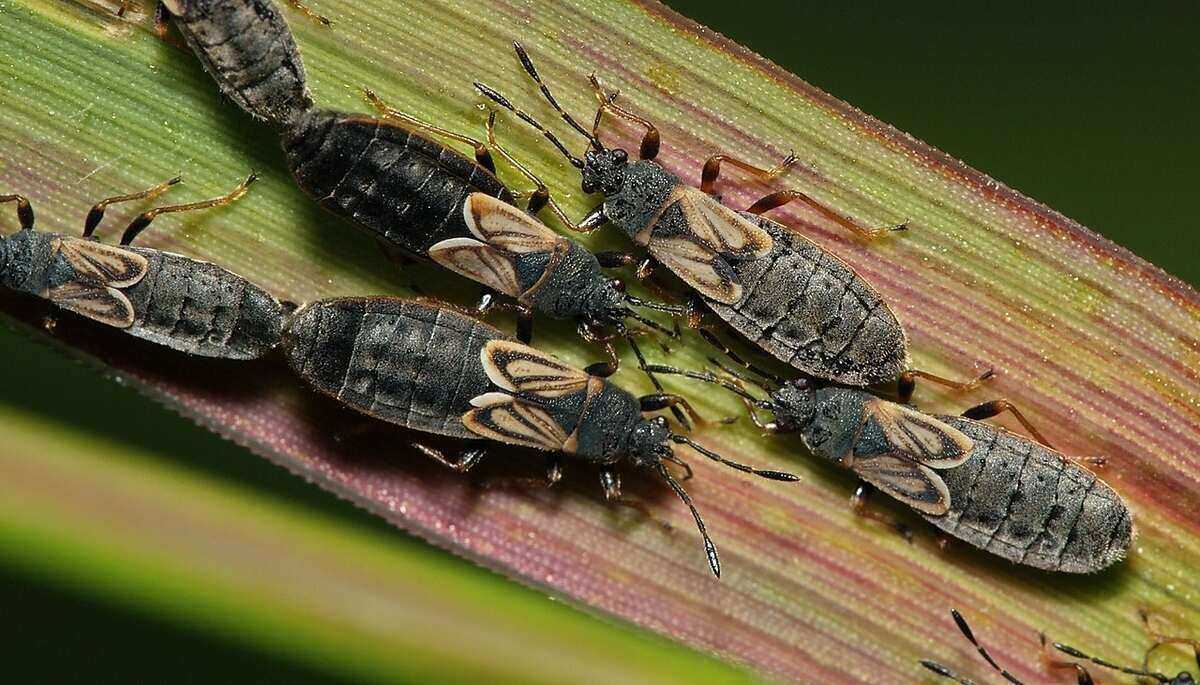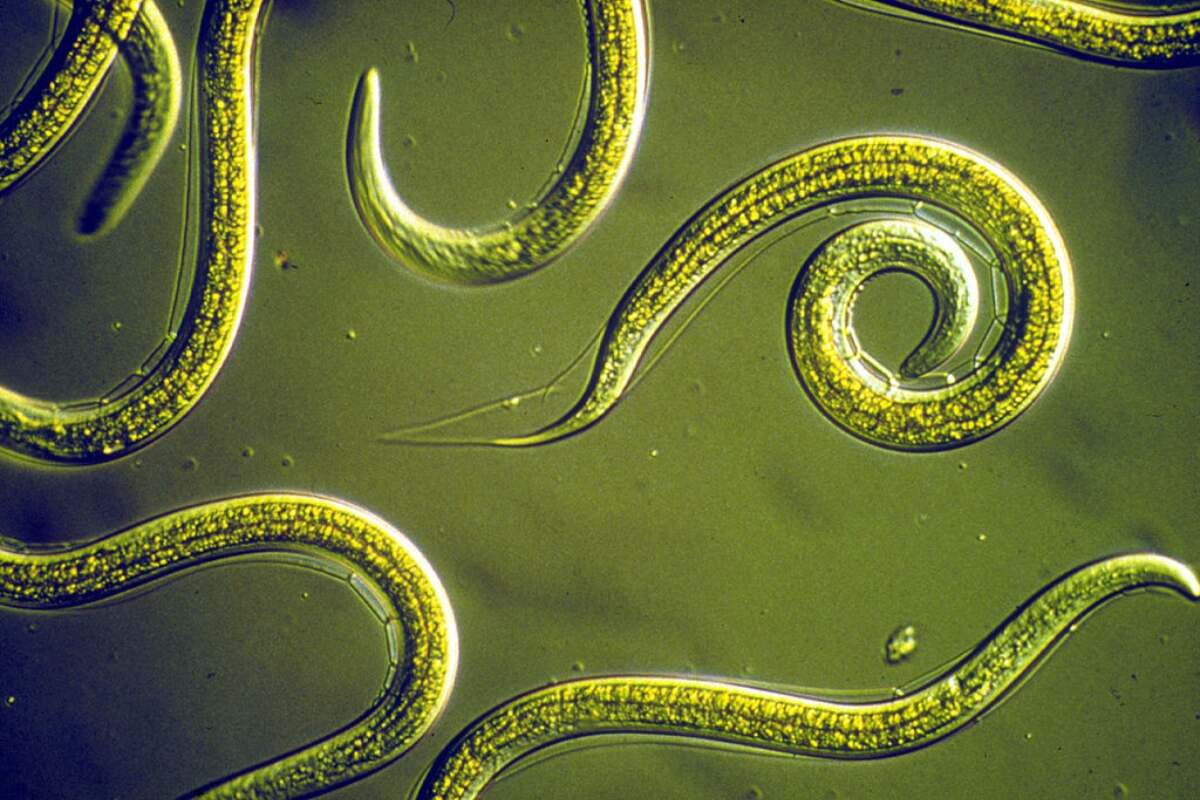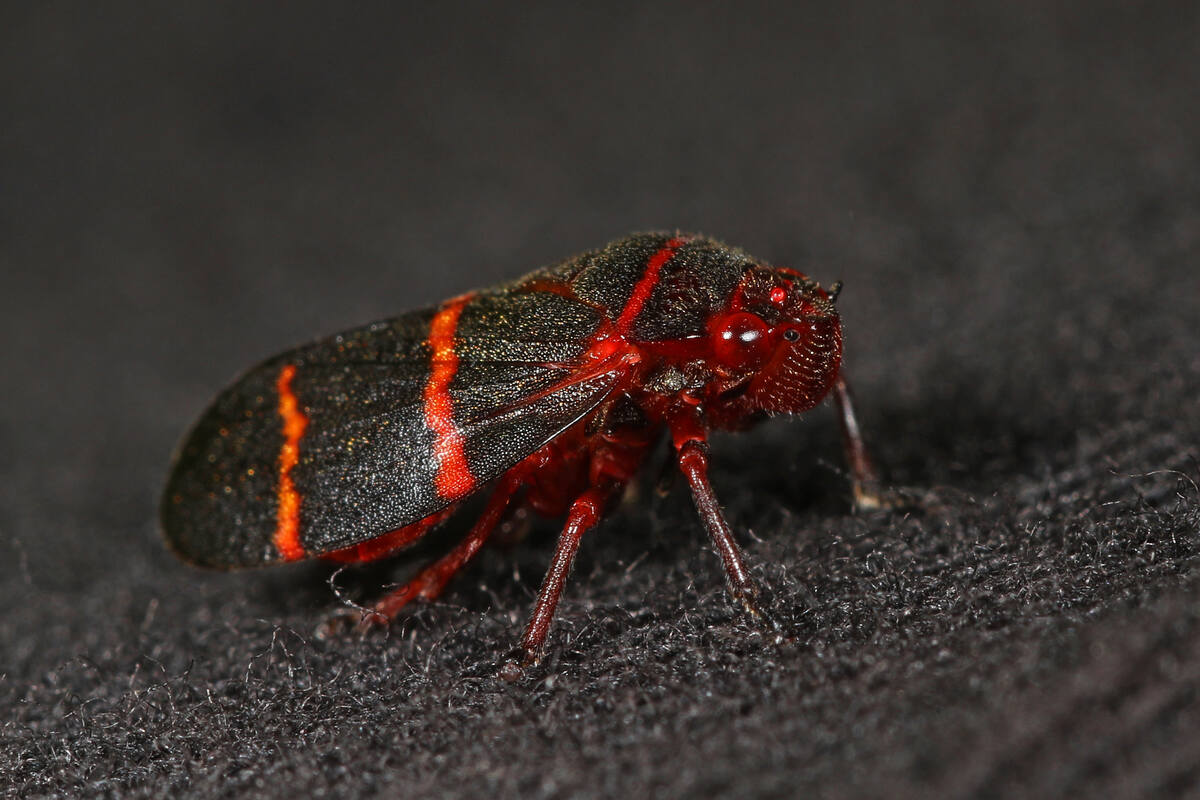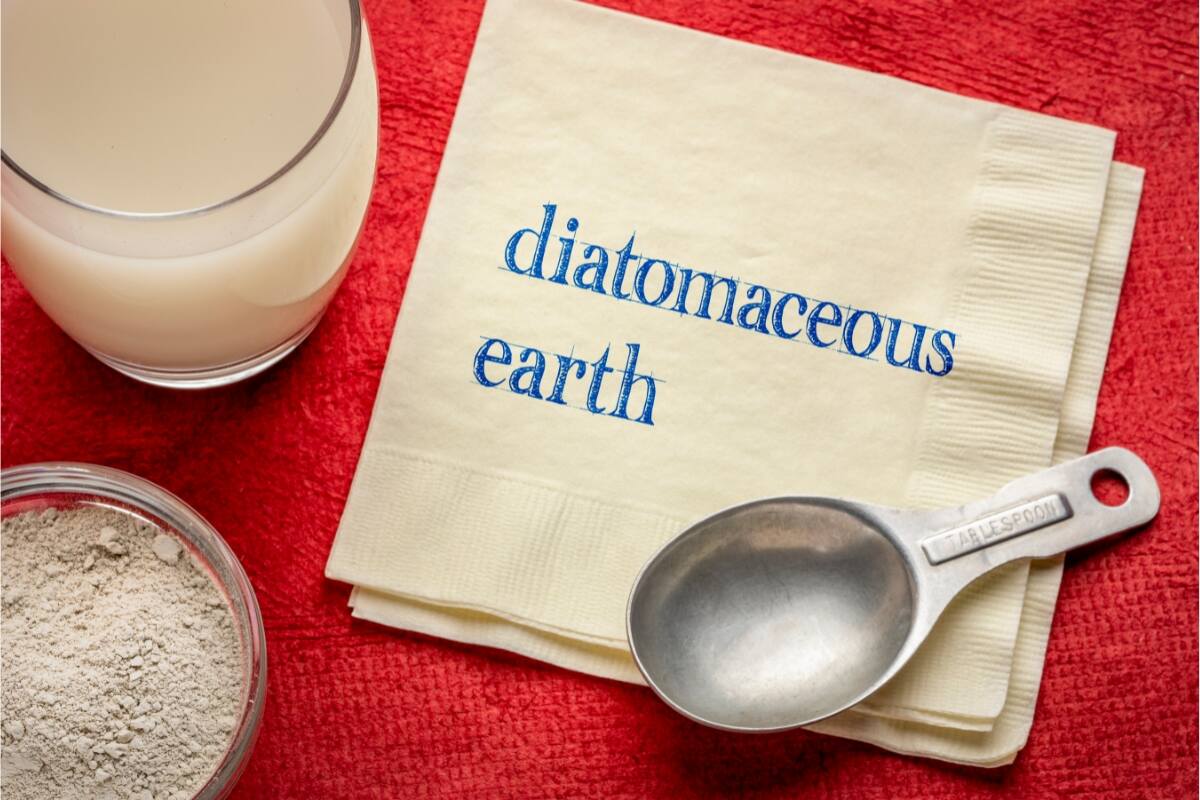
Wondering how to use diatomaceous earth for lawn pest control? Spread a thin coat of food-grade diatomaceous earth (DE) on your lawn on a windless day with no rain in the forecast for 24 to 48 hours. Focus on pest-infested areas. Do it again if heavy dew sets in the morning. Repeat every 3 to 4 weeks.
But there’s more to learn about this naturally occurring insecticide, used for decades by pest control professionals but still unfamiliar to most home gardeners and lawn owners.
How effective is it? What bugs does it kill? Is this flour-like powder safe for beneficial insects and the environment? What about kids and pets? We discuss all its best and not-so-good features in this article, so you can use diatomaceous earth like a pro and get the best results possible for your lawn.
- What is Diatomaceous Earth?
- How to Use Diatomaceous Earth for Pest Control
- How to Avoid Harming Pollinators
- Pros and Cons of Using Diatomaceous Earth as an Insect Killer
- Why is Diatomaceous Earth Used as a Pesticide?
- Common Pests Diatomaceous Earth Might Not Kill
- Types of Diatomaceous Earth and Where to Buy Food-Grade
- Other Uses For Food-Grade Diatomaceous Earth
- FAQ About Diatomaceous Earth as Pest Control
What is Diatomaceous Earth?
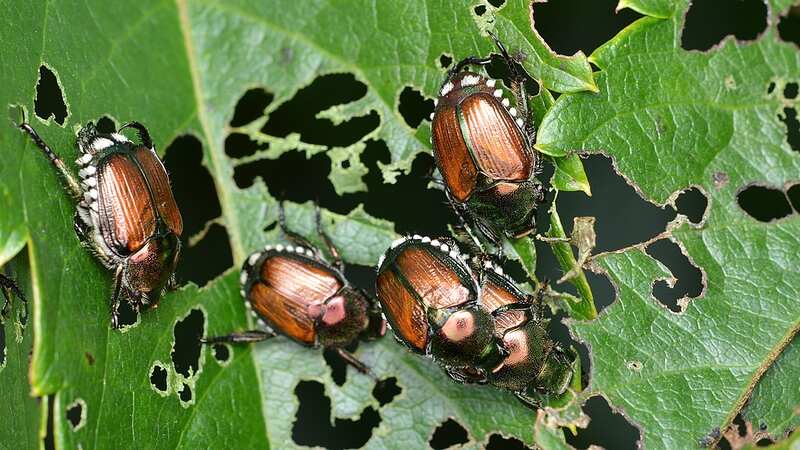
Packaged diatomaceous earth is an off-white, fine powder. It has a neutral taste, no smell, and looks like chalk or talc. Also referred to as DE, diatomite, Kieselgur, or Kieselguhr, it’s made of the fossilized shells of aquatic organisms called diatoms.
These single-cell algae have lived in streams, river beds, and oceans around the globe for millions of years. Ancient water beds shelter their graveyards and are mined today for the precious rock formed by diatoms’ petrified remains – the diatomaceous earth.
When grounded, DE becomes a fine powder with endless uses. One of them is pest killing.
How to Use Diatomaceous Earth for Pest Control
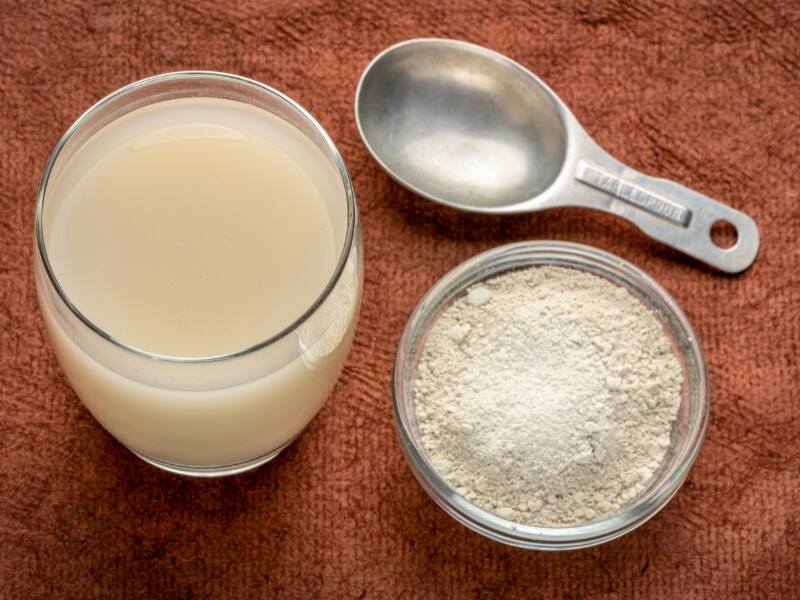
Diatomaceous earth is an excellent natural pesticide to use for eco-friendly lawn care. As with traditional insecticides, its efficiency depends on how you use it.
Here’s how to use diatomaceous earth as organic pest control for your lawn and make the most of its pest-killing power:
1. Opt Between Powder or Liquid Solution
Depending on the situation, you can apply diatomaceous earth as a powder or liquid solution on your turfgrass.
- The dry form makes it easier to coat small areas and create circles around the infested patches.
- Dissolved in water, DE is easier to spread on large surfaces and hard-to-reach places, like tall trees or dense shrubs around the lawn. Keep in mind that water is only a carrier. The solution must dry out to become effective, which can take 1 to 2 hours.
2. Wait for the Right Weather
The best opportunities to apply diatomaceous earth are windless days with no rain in the forecast for 24 to 48 hours. Here’s why:
- The DE powder has very fine particles. Wind can sweep it away, spreading it everywhere but where needed.
- Diatomaceous earth powder can only harm pests with its miniature razor blades when dry. If it rains and the powder gets wet, it’s useless until it dries up. After it dries up, it works again. But it might be clumped up in the corner of your lawn or washed off on your driveway or into your storm drains. If it rains, it’s a good idea to spread it again.
3. Use Only Food-Grade Diatomaceous Earth
The correct option of diatomaceous earth for yards is the food-grade form. Food-grade DE is safe for humans, wildlife, and pets. It’s the correct option to use as a pesticide on your lawn, garden, greenhouse, crop field, etc.
Important note: Never use pool-grade diatomaceous for pest control in your yard. We’ll discuss it in detail later in this article.
4. Wear Protective Equipment
Food-grade diatomaceous earth is not poisonous to humans. Still, the Centers for Disease Control and Prevention (CDC) mentions that it can irritate your nasal passages and airways if inhaled, making you cough and sneeze.
DE is also irritative for your eyes if exposed and can cause dryness to your skin by absorbing its natural moisture and oils.
To spread DE correctly and safely, wear the following protective gear:
- A dust mask
- Protective glasses
- Garden gloves
5. Spread Dry Diatomaceous Earth Correctly
If you’re wondering how to spread diatomaceous earth on your lawn, it will depend on whether you opt for dry or wet DE.
To spread dry DE powder over the grass, you’ll need:
- Diatomaceous earth powder
- A garden spreader or dust applicator (you can also use a flour strainer or a turkey baster)
Treating your lawn with dry diatomaceous earth is pretty straightforward and includes seven steps:
- Step 1: Prepare the lawn by spreading a soft water mist with your sprinkler system to ensure some powder sticks to the thin grass leaves. Since most lawn pests are soil-dwelling or travel partially by soil, it is usually more important to get the powder on the ground than on the foliage.
- Step 2: Put your protective gear on. Cover as much of your skin and face as possible.
- Step 3: Look for signs of pest infestation (brown, thinned, wilted, dead grass). DE also harms beneficial insects, so apply the powder only in areas showing signs of infestation or more likely to harbor pests (moist, shady places, etc.) to minimize the danger to bees, butterflies, and other helpful pollinators.
- Step 4: Fill the garden duster with powder and close it tightly.
- Step 5: Start spreading the powder in a thin and even layer across the affected area of your lawn. If you make it too thick, insects might avoid passing through it. Keep the spreader about six inches above the ground and squeeze to get the powder out. Give it a good shake if the powder refuses to come out.
- Step 6: Finish by circling the targeted area with a continuous line of DE powder. Also, apply on neighboring flower beds that show signs of infestation.
- Step 7: Repeat the application weekly for a month for an extensive infestation or every 3 to 4 weeks during their active season to keep pests under control.
Some DE manufacturers include a spreader in the package, or you can get one online. Here are a few inexpensive and easy-to-use dusters for applying dry DE:
6. Spray Liquid Diatomaceous Earth
A liquid solution can be easier to apply if your whole lawn or a large patch is infested with mole crickets, beetles, or grasshoppers and needs treatment. To do this, you’ll need:
- Diatomaceous earth powder
- Water
- Spray bottle (for spot treatments) or garden pump sprayer (for larger areas — you can buy one online from retail stores like Amazon or Walmart)
It’s easy to apply diatomaceous earth spray to your yard, you just have to follow five simple steps:
- Step 1: Prepare the solution. The most common ratio to obtain a good concentration of DE is four tablespoons of powder to one gallon of water.
Fill the garden sprayer with water and add the diatomaceous powder. Stir thoroughly until the powder dissolves completely. The solution has a sticky texture.
- Step 2: Spread the solution uniformly across the lawn. Apply a thick coat to ensure the solution reaches the soil surface but not too much to create runoff.
- Step 3: Go around the lawn and spray the edges.
- Step 4: Reapply if strong wind, rain, or heavy dew compromises the initial layer after you spray it and before it’s had time to dry.
- Step 5: With an extensive infestation, repeat the application weekly until the pest population is under control. Otherwise, repeat every 3 to 4 weeks to keep pests under control.
Where to buy liquid sprayers:
How to Avoid Harming Pollinators
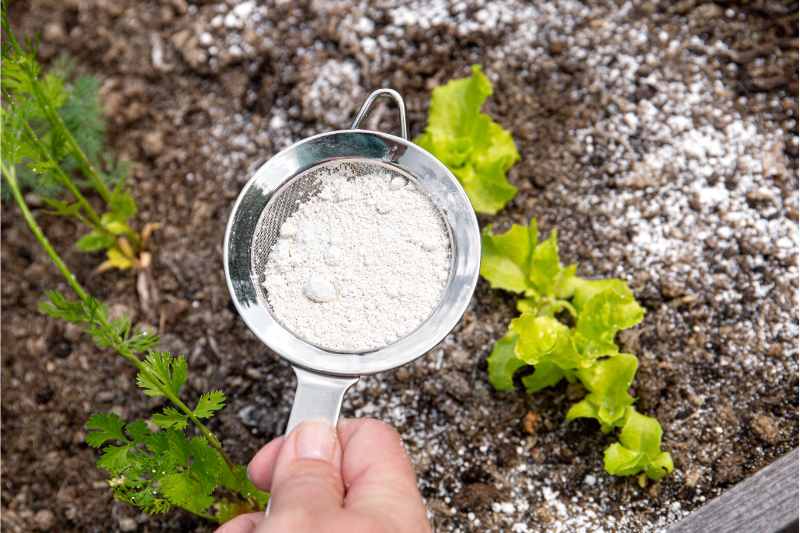
Diatomaceous earth is a great natural insecticide for organic vegetable gardens. It doesn’t pollute the soil or local bodies of water, and it doesn’t contaminate produce. DE keeps your crops clean of chemicals while eliminating many garden pests like squash bugs, Colorado potato beetles, aphids, tomato hornworms, Japanese beetles, flea beetles, and more.
Nevertheless, applying DE in your garden comes with a red flag: Diatomaceous earth can harm pollinators. While a naturally occurring pesticide, diatomaceous earth doesn’t differentiate between beneficial insects and pests and can also affect your garden’s precious bees and ladybugs.
Fortunately, there are some measures you can take to protect them.
1. Use on Infested Areas Only
Bugs don’t run up and down your garden like crazy, taking a bite from every plant. They’re quite methodical in their eating habits, and spotting their feeding ground is usually easy.
Spread the killer powder where you see bunches of chewed leaves and stems. Work in circles
around damaged plants. You must ensure your targets can’t get in or out of the infested area without getting some powder on their bodies.
Try to help save bees by avoiding the areas where you see them flying. If you spot bees buzzing around a treated corner in your garden, washing the powder off is a good idea. Postpone the application later in the day.
2. Apply DE in the Evening
Bees and ladybugs are less active at the end of the day and start flying the next day only after it warms up a bit.
When you spread the powder in the evening, you reduce the risk of pollinators getting into the treated areas while the powder is freshly spread and dense.
3. Spread on the Ground
If you’re treating slugs, grubs, beetles, spider mites, earwigs, sowbugs, cutworms, mole crickets, and other species that spend time on the soil, spread the DE on the ground.
Create complete circles around your infested plots or individual plants. Pollinators mostly visit the top of the plant where the flowers are and are safe from soil applications.
4. Avoid Flowers and Top Leaves
Don’t apply DE on the flowers, and also avoid the first layers of leaves next to them. If the top of the plant is overwhelmed by aphids or ants, it’s better to cut the top leaves than to spread DE on them.
4. Consider Ladybugs or Nematodes to Get Rid of Aphids
Aphids are the preferred snack of ladybugs. The safest way to get rid of aphids with DE without killing ladybugs looking for food is to spread powder on the plants in the evening and wash them thoroughly in the morning before ladybugs start their rounds. This is typically enough time to get most aphids exposed to the pesticide.
One ladybug eats up to 5,000 aphids during its lifetime. If you give these beautiful pollinators time to multiply, ladybugs will eliminate your aphid infestation. It just takes some time for them to reproduce and grow a large enough army.
If such a short-term application of DE doesn’t sound good to you, consider using another excellent organic pesticide that doesn’t harm ladybugs — beneficial nematodes.
Pros and Cons of Using Diatomaceous Earth as an Insect Killer
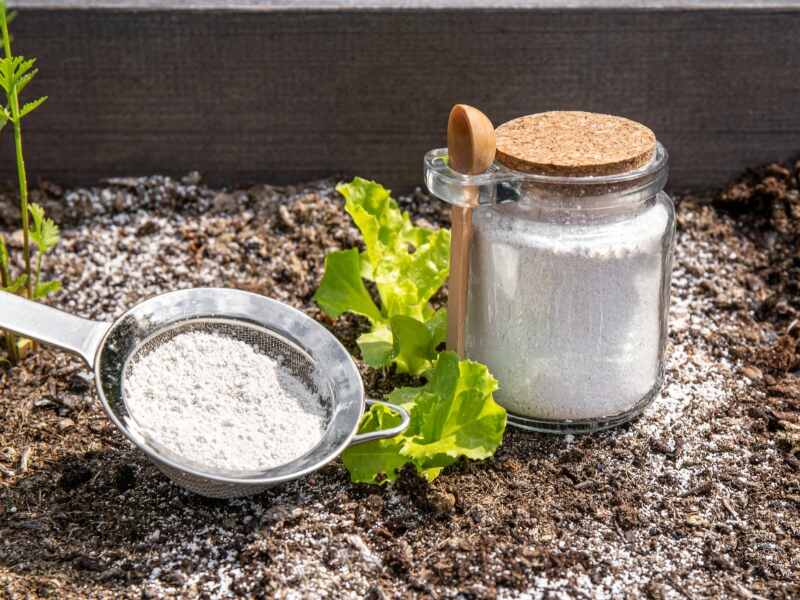
Diatomaceous earth has pros and cons, like any other pesticide. Let’s see what you put in the balance when deciding whether to use it.
Pros
✓ A natural, organic pesticide that does not pollute the environment. It’s almost 90% silica, which travels back into rivers, lakes, seas, and oceans, and it’s used at some point to build new shells by aquatic life.
✓ Not poisonous for people, animals, and fish.
✓ It adds useful minerals when it breaks down into the soil.
✓ It kills a wide range of pests.
✓ It’s a mechanical pesticide, not a chemical one, so pests can’t develop immunity. This property makes it an excellent addition to integrated pest management plans, in addition to chemical pesticides and effective cultural practices.
✓ Safe to use indoors and outdoors.
✓ Highly accessible and inexpensive.
Cons
✗ Its efficiency depends on the weather.
✗ It can harm pollinators if misused because it is not a selective pesticide.
✗ DE particles can irritate the eyes, nose, and throat if exposed. Inhaled in large amounts or over long periods, it can cause lung health issues in professionals mining, processing, or spreading DE.
✗ When wet, it becomes useless.
✗ You need to apply it correctly for it to work. If it’s spread too thick, pests will avoid it.
Why is Diatomaceous Earth Used as a Pesticide?
Diatomaceous earth is a natural organic pesticide often used as natural pest control for lawns, gardens, and greenhouses. It’s gentler and safer for the environment than harsh chemical pesticides, but it still does an excellent job. You’ll be surprised how many pests it can kill. Pest insects that come into contact with DE powder die by desiccation in 12 to 24 hours.
But how can seashell powder kill your lawn pests? Mainly because of its high silica content:
- Silica dust is highly absorbent. When insects walk, jump, or slide through the DE powder and get silica on their bodies, it sucks out oils and fats in their waxy exoskeletons, making them fragile and dry.
- Silica is also highly abrasive. While silky-smooth for your fingertips, DE powder feels like glass shards for small beings like insects. Tough as diamonds, silica particles have razor-sharp edges that scratch their bodies and protective shields, cutting the insects and exposing them to heat and dryness.
According to the National Pesticide Information Center, DE is used in its pure form and as an active ingredient in over 150 commercial pesticides for application in lawns, gardens, homes, pet kennels, farms, and orchards.
Common Pests Diatomaceous Earth Might Not Kill
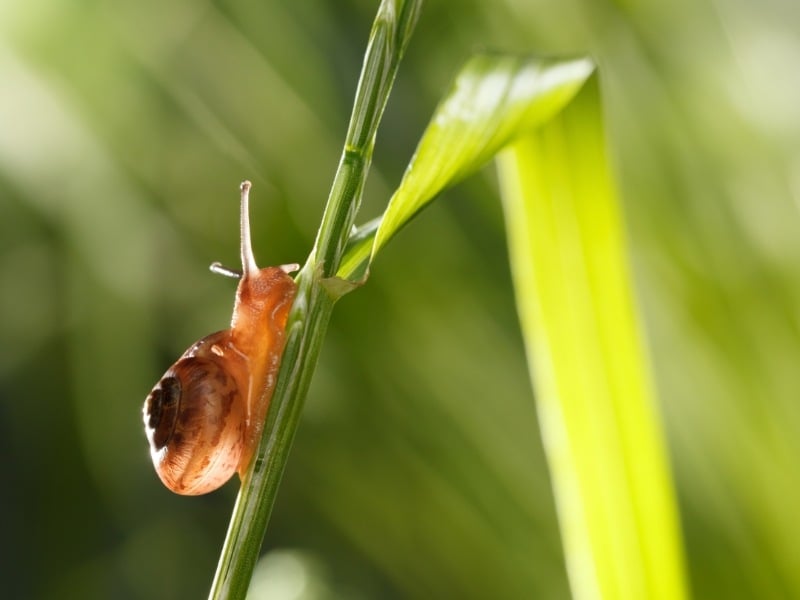
Diatomaceous earth might not be effective in killing slugs and snails. Some say they are protected from its sharp touch by their thick mucus, and that DE only slows them down and discourages them from feeding on your plants. In other words, it’s unpleasant but not deadly.
Others say DE powder gets inside the snail’s shell and irritates the animal, forcing it to leave the shell behind. Exposed to the elements without the protective layer, a snail can’t survive for long.
The bottom line is: If you want to keep these slimy fellows under control, consider combining DE with other methods and following an integrated pest management plan for the lawn. For example, use preventive measures like:
- Turning over winter mulch to expose their hiding places.
- Tilling the soil in the spring.
- Avoiding watering in the evening.
Copper tapes and slug collars are simple and inexpensive tools to protect your plants from hungry mouths. Here’s where you can find some:
Types of Diatomaceous Earth and Where to Buy Food-Grade
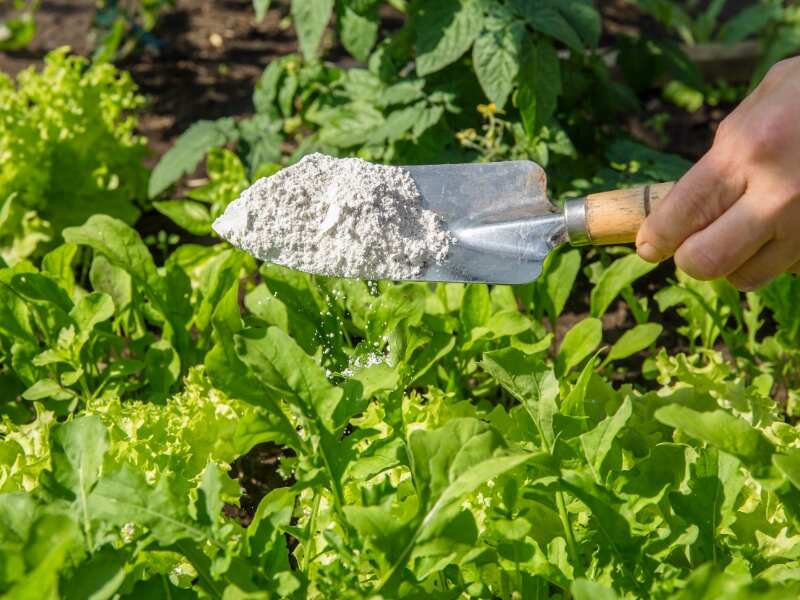
There are two types of diatomaceous earth: pool-grade and food-grade. They differ in their degree of processing and chemical content. Only food-grade diatomaceous earth should be used for pest control.
Pool-Grade Diatomaceous Earth
The pool-grade form is treated under high heat, a process called calcination, which makes its content rich in crystalline silica. If inhaled, crystalline silica is highly toxic to our respiratory system, so you shouldn’t expose yourself, your family, or your pets to pool-grade DE.
Calcination improves DE’s filtering properties, making it great for keeping your pool water clean. But again, it’s harmful to pets and humans. Don’t use pool-grade DE as a pesticide.
Food-Grade Diatomaceous Earth
On the other hand, food-grade diatomaceous earth is made of freshwater diatomite and purified to eliminate traces of nasty elements like arsenic or lead. Although it can irritate the mucous membrane in your nose, eyes, and throat if inhaled, food-grade diatomaceous earth does not kill grass, and is not poisonous for humans or animals.
Only use food-grade diatomaceous earth for your garden. It’s the only form safe for you, your family, and your pets.
The OMRI also recognizes food-grade DE as an organic pesticide that you can use in your organic garden, along with neem oil, insecticidal soap, and beneficial nematodes. DE is inexpensive and widely available in local garden stores and online.
Here are some popular labels of DE that gardeners and lawn owners buy:
Warning: Don’t eat food-grade DE that you buy as a pesticide. If you intend to use it for medicine or food, buy products specially made for this purpose.
Other Uses For Food-Grade Diatomaceous Earth
Diatomaceous earth is extremely generous when it comes to DIY uses:
- You can rely on DE to eliminate fleas in your house. Just spread it on all your carpets and vacuum after half a day.
- If you’re raising chickens, it’s also excellent in deterring bird lice. Mix it with sand in a large box where chickens can take dust baths. Ensure some coverage to protect the sand from rain and keep it dry. Chickens don’t like bathing in wet sand, and the water will render DE ineffective.
- Diatomaceous earth works great as a natural pest control agent for roaches that might visit your kitchen. Spread a fine layer of DE powder around cabinets, doors, windows, baseboards, storage units, and corners.
- You can also use DE to deter pests crawling into walls, ceilings, and furniture, like ants, termites, and baby cockroaches. Spread DE powder in wall holes, inside furniture, and any visible crevices around the house. It remains effective for a long time.
- Food-rate diatomaceous earth contains useful minerals like silicon dioxide, iron oxide, potassium, phosphorus, magnesium, and calcium. You can use it as fertilizer in your garden mixed in the topsoil.
- It also improves water absorption in the soil you use for potted plants. Diatomaceous granules help with water drainage and create an excellent hydroponics base.
DE powder from the food-grade category is also used in a large variety of non-pesticide products, such as:
- Foods and beverages (food-grade DE is used to clarify wine)
- Toothpaste (as an abrasive agent)
- Cosmetic products (as an abrasive, anticaking, or opacifying agent)
- Medicine (used to treat constipation and high cholesterol levels)
- Deparasitic for pets (used topically to get rid of ticks and fleas or internally as a de-worming solution)
FAQ About Diatomaceous Earth as Pest Control
How Long Does It Take for Diatomaceous Earth to Kill Insects?
Pest insects that get dry diatomaceous earth on their bodies die of desiccation in 12 to 24 hours. A significant change in pest population typically appears after 5 to 7 days.
What Types of Insects Does Diatomaceous Earth Kill?
Diatomaceous earth kills insects with an exoskeleton (exterior skeleton). The outer skeleton is a defining feature of arthropods, including insects (bed bugs, termites, ticks, earwigs, beetles, mole crickets), crustaceans, and spiders.
Gardeners and lawn care professionals who follow organic pest control guidelines use diatomaceous earth to eliminate:
- Mole crickets
- Fire ants
- Japanese beetles
- Fleas
- Spider mites
- Bed bugs
- Silverfish
- Snails
- Earwigs
- Aphids
- Ticks
- Grasshoppers
- Cockroaches
- Squash bugs
- Fungus gnats and more
Note: DE kills the larvae and adults of these insects but not the eggs.
Is It Ok to Combine Diatomaceous Earth With Water?
You can dissolve diatomaceous earth in water to spray it over your lawn, vegetables, flower beds, trees, etc. The best ratio is four tablespoons of DE to one gallon of water. Remember that the diatomaceous earth needs to dry to become active and kill the bugs.
Is Diatomaceous Earth Safe for Kids and Pets?
Accidental exposure of children or pets to food-grade diatomaceous earth when used for gardening is not toxic. But, the powder can still irritate the nose and throat if inhaled and the eyes if the wind blows it in the face. To avoid unpleasant experiences, keeping kids and pets away from the lawn or garden during DE application is better.
Call a Pro to Enjoy a Green, Lush, Pest-Free Lawn
Diatomaceous earth protects your lawn from nasty pests without polluting the soil and local waterways. It’s one of the best options for organic pest control, and since insects don’t develop immunity, it’s a solution you can always count on!
If you don’t feel like applying diatomaceous earth on your own, contact a local lawn care pro specializing in organic lawn pest control to schedule an application. Say goodbye to brown patches and enjoy a green, lush, pest-free lawn without harming your local environment!
Main Photo Credit: marekuliasz / Canva Pro / License
LawnStarter participates in the Amazon Services LLC Associates Program, an affiliate advertising program. LawnStarter may earn revenue from products promoted in this article.

